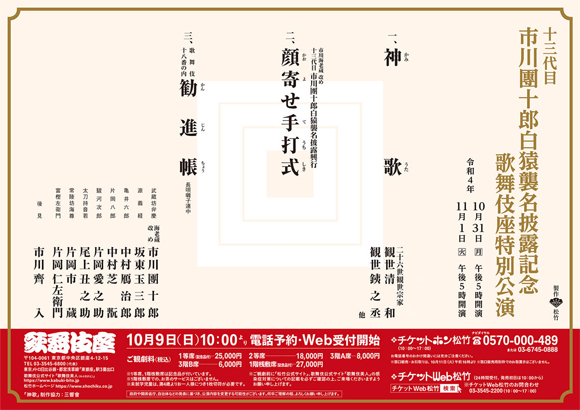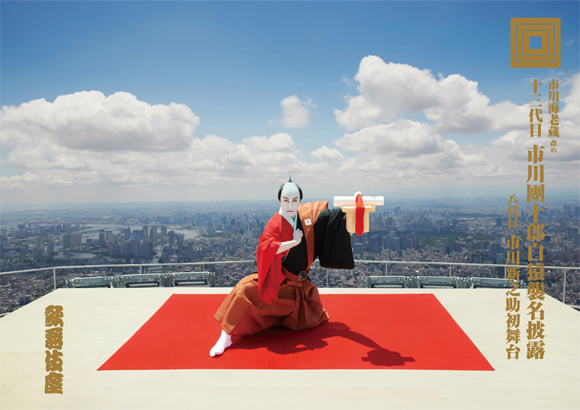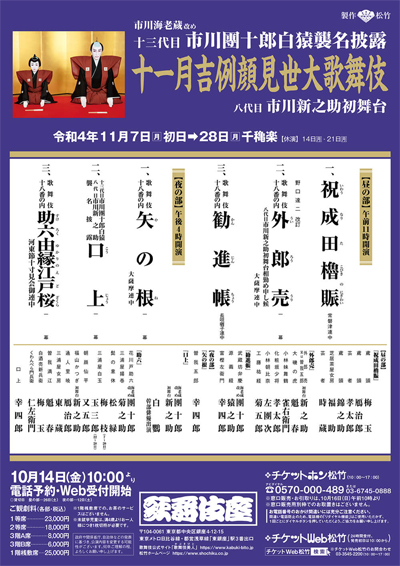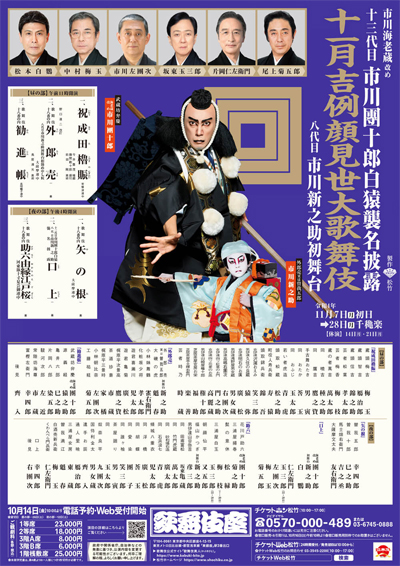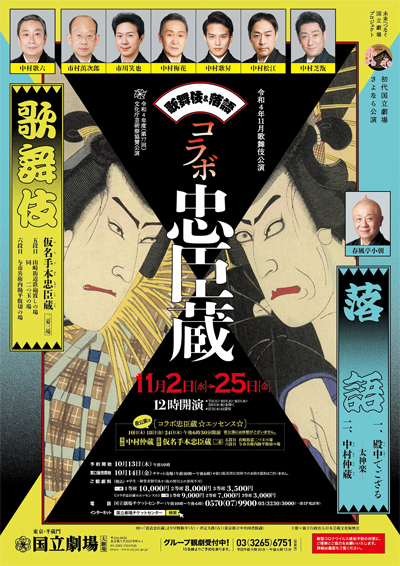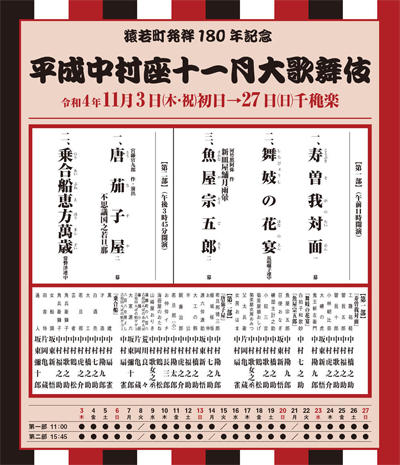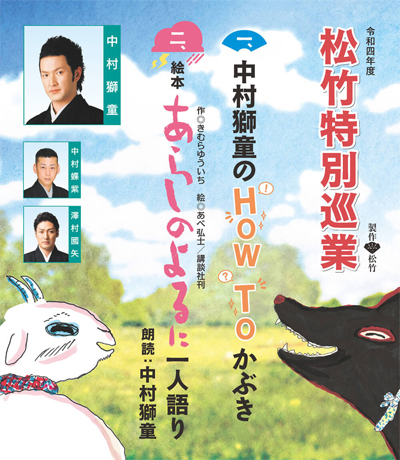| Dates |
7 ~ 28 November 2022
Kichirei Kaomise ďkabuki
Annual Festive Face-Showing Grand Kabuki |
| MatinÚe |
Iwau Narita Kobiki no Nigiwai
Uir˘ Uri
Kanjinch˘
|
| Evening |
Ya-no-Ne
K˘j˘
Sukeroku Yukari no Edo Zakura
|
| Casting |
Ichikawa Danjűr˘, Ichikawa Shinnosuke,
Living National Treasure Onoe Kikugor˘, Living National Treasure Kataoka Nizaemon, Living National Treasure Band˘ Tamasabur˘, Living National Treasure Nakamura Baigyoku, Living National Treasure Nakamura T˘z˘,
Matsumoto Haku˘, Nakamura Jakuemon, Onoe Kikunosuke, Nakamura Tokiz˘, Nakamura Fukusuke, Nakamura Kaishun, Matsumoto K˘shir˘, Ichikawa Ennosuke, Nakamura Ganjir˘,
Kataoka Takatar˘, Onoe Sh˘roku, Nakamura Kinnosuke, Ichikawa Sadanji, Nakamura Matagor˘, Nakamura Baishi,
Ichikawa Udanji, Nakamura Kotar˘, Band˘ Minosuke, Ichikawa Monnosuke, ďtani Tomoemon, Band˘ Rakuzen, Ichikawa Sai'nyű, Kataoka Ichiz˘, Band˘ Hikosabur˘, Band˘ Kamez˘, Ichikawa Komaz˘, Kawarasaki Gonjűr˘, Ichimura Kakitsu, Matsumoto Kingo, Ichikawa Omez˘, Ichikawa En'ya, Ichikawa Juen, Ichikawa Emisabur˘, Ichikawa Seiko,
ďtani Hirotar˘, ďtani Hiromatsu, Nakamura Kangyoku, Nakamura Mantar˘, Nakamura Tanenosuke, Nakamura Takanosuke, Ichikawa Otora, Ichikawa Somegor˘, Nakamura Tamatar˘, Onoe Sakon, Ichikawa Danko, Ichikawa Kudanji, Kataoka Matsunosuke, Nakamura Kichinoj˘
|
| Comments |
Ichikawa Ebiz˘ XI takes the name of Ichikawa Danjűr˘ XIII in T˘ky˘ at the Kabukiza.
It is also the hatsubutai for his son Ichikawa Shinnosuke VIII.
This is the first month of a 2-month shűmei
for the Naritaya guild, in November and December 2022.
Iwau Narita Kobiki no Nigiwai: it is festival day in the bustling city of Edo, where the proprietress of a theatre teahouse,
chiefs of the fire brigade and geisha all turn out and dance happily.
This is a dance accompanied by Tokiwazu music, which grandly opens the performances celebrating
the name succession of Ichikawa Danjűr˘ XIII.
Uir˘ Uri: there are many plays based on the revenge by the Soga brothers
on Kud˘ Suketsune (Living National Treasure Onoe Kikugor˘), the man that arranged to have their father killed.
In this particular play, this dramatic fight is transformed into light fantasy
by showing one of the Soga brothers disguised as a peddler of uir˘, a medicine
that makes it possible to speak quickly and elegantly. The highlight of the
play is a long speech full of puns and wordplays. Starring Ichikawa Shinnosuke as the peddler.
Featuring also Nakamura Jakuemon, Nakamura Kaishun, Ichikawa Sadanji and Kataoka Takatar˘.
Kanjinch˘: probably the most popular Kabuki play today,
it includes dance, comedy and the heart-warming pathos of a band of heroes
during their last days. Disguised as a band of traveling priests the
fugitive general Yoshitsune and his small band of retainers are stopped at a
road barrier. They escape only through the quick thinking of the head retainer,
a warrior priest named Musashib˘ Benkei, who improvises the text of an elaborate imperial
decree. Having escaped danger Benkei and the others describe their days of
glory and hardships on the road to escape in a moving dance.
This program stars Ichikawa Danjűr˘ in the role of Benkei,
with Ichikawa Ennosuke and Matsumoto K˘shir˘ as Yoshitsune and the barrier keeper Togashi.
Ya-no-Ne: like a picture come to life, this play combines the most
exaggerated costumes and movements with leisurely humor. The aragoto
hero Soga no Gor˘ is sharpening a giant arrow and sleeping in wishes of good fortune
for the New Year when he sees his brother Jűr˘ in a dream asking him to come and rescue him.
The two Soga brothers are part of one of the most popular vendetta stories in Kabuki,
suffering for eighteen years before being able to avenge the death of their father.
In this play, when Gor˘ finds out that his brother is in trouble, he jumps on
the horse of a passing daikon vendor and,
brandishing a giant daikon as a whip prepares to rush to his brother's side.
Starring Matsumoto K˘shir˘ and Band˘ Mitsugor˘ as Gor˘ and Jűr˘.
K˘j˘: the close relationship between the actors and the audience
is shown by these stage announcements, lavish ceremonies to commemorate various
important events. In this case, all the stars of the cast assemble to celebrate the shűmei of
Ichikawa Danjűr˘ XIII and the hatsubutai of Ichikawa Shinnosuke VIII.
Sukeroku: the dandy Sukeroku is the most famous patron of the
Yoshiwara pleasure quarters.
But his reputation as the lover of Agemaki,
the highest ranking courtesan in the quarter is matched by that of his
tendency to pick fights. In fact, Sukeroku is the samurai Soga no Gor˘
in disguise, and he uses the fights to find a lost heirloom sword.
His search takes place in the colorful atmosphere of the Yoshiwara
where processions of beautiful courtesans compete with the splendor of
cherry blossoms in full bloom. All the top stars in Kabuki appear in
a procession of beautiful, exciting and amusing roles.
Starring Ichikawa Danjűr˘ and Onoe Kikunosuke as Hanakawado Sukeroku and Miuraya Agemaki.
Featuring also Onoe Sh˘roku, Living National Treasure Nakamura Baigyoku, Ichikawa Shinnosuke, Nakamura Kaishun, Nakamura Ganjir˘, Nakamura Matagor˘ and Living National Treasure Kataoka Nizaemon
in the roles of Ikyű, the shirozake seller Shinbŕ, Fukuyama Katsugi, Mank˘, the passer-by, Asagao Senpei and Kanpera Monbŕ.
The role of the courtesan Miuraya Shiratama is played by Living National Treasure Band˘ Tamasabur˘ (from the 22nd to the 28th) and Nakamura Baishi (from the 7th to the 20th).
Sources: Earphone Guide Website or Sh˘chiku Kabuki Official Website
|
| Dates |
2 ~ 25 November 2022
Kabuki & Rakugo Korabo Chűshingura
A collaboration related to Chűshingura between Kabuki and Rakugo |
| Program |
Denchű Degozaru
A famous rakugo narrated by Shunpűtei Koasa
Nakaz˘
A famous rakugo narrated by Shunpűtei Koasa
Kanadehon Chűshingura
Tepp˘ Watashi, Futatsudama
Kanpei Harakiri
|
| Casting |
Nakamura Shikan, Nakamura Karoku, Ichimura Manjir˘, Ichikawa Emiya, Nakamura Kash˘, Nakamura Matsue, Nakamura Baika
|
| Comments |
The 1st farewell Performances before the closing and the start of the rebuilding of this theater. This progam belongs to the series of performances from November 2022 to october 2023 labeled as Mirai e Tsunagu Kokuritsu Gekij˘ Purojekuto ~ Shodai Kokuritsu Gekij˘ Sayonara K˘en
(literally 'Project to Connect the National Theater to the Future ~ First generation National Theater Farewell Performances').
The November Kabuki at the National Theatre is mixed for the first time with another stage art: this program is entitled Kabuki & Rakugo Korabo Chűshingura (A collaboration related to Chűshingura between Kabuki and Rakugo).
Tepp˘ Watashi/Futatsudama/Kanpei Harakiri:
this section of the classic "Kanadehon Chűshingura" is about
Hayano Kanpei (Nakamura Shikan) and his wife Okaru (Ichikawa Emiya). Kanpei survives as a hunter and is desperate
for the money that will allow him to become a samurai again. He encounters two
former retainers of Lord En'ya Hangan who offer to allow him to participate in
a vendetta to avenge Lord En'ya Hangan's death by attacking K˘ no Moron˘.
Unknown to him, though, Okaru's family has decided to raise the memory by
selling her into prostitution as a courtesan in the Gion district of Ky˘to.
Okaru's father travels on a dark mountain road, eager to bring the first half
of the money to Kanpei. But he is attacked and robbed by Sadakur˘ (Nakamura Karoku),
also a former retainer of Lord En'ya Hangan who has gone bad and become a thief.
At this point, Kanpei aims and fires at s wild boar and instead kills Sadakur˘.
He finds the purse with all the money and, thinking that is the gift of heaven,
rushes home. At home, the brothel keeper is already there to collect Okaru and
Kanpei wants to refuse to let her go, until he realizes where the money came
from and believes that he killed Okaru's father by mistake.
He urges Okaru to go to the pleasure quarters, not wanting her to know what has
happened. In one of the dramatic highlights of the play,
Kanpei commits suicide to atone for his multiple failures in duty.
Sources: Earphone Guide Website or Sh˘chiku Kabuki Official Website
|
| Heisei Nakamuraza (T˘ky˘) |
| Dates |
3 ~ 27 November 2022 |
| 1st program |
Kotobuki Soga no Taimen
Shiraby˘shi no Hana no En
Shin Sarayashiki Tsuki no Amagasa
(Sakanaya S˘gor˘)
|
| 2nd program |
T˘nasuya ~ Fushigi no Kuni no Wakadanna
Noriaibune Eh˘ Manzai
|
| Casting |
Nakamura Kankur˘, Nakamura Shichinosuke, Nakamura Senjaku, Band˘ Yajűr˘, Kataoka Kamez˘, Band˘ Shingo, Nakamura Tsurumatsu, Nakamura Hashinosuke, Nakamura Fukunosuke, Nakamura Utanosuke, Nakamura Toranosuke, Nakamura Kantar˘, Nakamura Ch˘zabur˘, Nakamura Kamenoj˘, Arakawa Yoshiyoshi
|
| Comments |
The Heisei Nakamuraza is back in T˘ky˘ in Asakusa in October and November 2022. Not in the Sumida Park as it used to be but in the precincts of the Sens˘ji Temple (at the back of the main temple hall).
This program commemorate the 180th anniversary of the 1842 move of all major Kabuki theaters to the remote district of Saruwaka-ch˘ (Edo).
Soga no Taimen: this is one of the oldest and most classical of all
Kabuki plays. In the Edo period, every January, plays appeared about the vendetta
carried out by the Soga brothers Jűr˘ and Gor˘ after eighteen years of hardship.
In "Soga no Taimen" the brothers confront Kud˘ Suketsune, the man responsible for
their father's death. More ceremony than play, it features each of the important
Kabuki character types, including the bombastic aragoto
style of Gor˘ and the soft wagoto style
of Jűr˘. This month features a cast headed by Nakamura Hashinosuke as Kud˘
and with Nakamura Fukunosuke as Gor˘ and Nakamura Utanosuke as Jűr˘.
Featuring Nakamura Toranosuke, Nakamura Tsurumatsu, Band˘ Shingo and Nakamura Kankur˘ as
Kobayashi no Asahina, the courtesan Kewaizaka no Sh˘sh˘ (Gor˘'s lover),
the courtesan ďiso no Tora (Jűr˘'s lover) and Oni˘ Shinzaemon (Jűr˘'s retainer).
Shiraby˘shi no Hana no En:
(The flowery Banquet of the shiraby˘shi)
In the medieval period there were beautiful dancers called shiraby˘shi
who wore male court costume. they were famous for dances called otoko mai or "male dance".
In this dance, Nakamura Shichinosuke evokes one of these beauties of ancient Japan.
Sakanaya S˘gor˘: S˘gor˘ (Nakamura Kankur˘), a fish seller, has taken a vow
to not drink, but when he learns about his sister's unjust murder at the hands
of a daimy˘ lord, a death that
they were told was execution for her wrongdoing,
he starts to drink again. Drunk, he storms into the lord's mansion to seek an
apology. This play by Meiji playwright Kawatake Mokuami is known for its
realistic portrayal of members of the common class during the Edo period
and highlights their fierce pride and frustration at the privileges of the
dominant samurai class.
Featuring also Nakamura Senjaku, Kataoka Kamez˘ and Band˘ Shingo.
T˘nasuya:
(The Pumpkin Vendor' alias 'Young Master's Adventures in Wonderland')
This is a brand new Kabuki play written and directed by Kud˘ Kankur˘.
It is based on the rakugo story "Tonasuya Seidan" which is set in Asakusa.
Disowned by his father for visiting the Yoshiwara pleasure quarters too often, the young master
Tokusabur˘ (Nakamura Kankur˘), who is about to throw himself off the Azumabashi Bridge into the Sumida River, will live an adventure interwoven with elements of "Alice's Adventures in Wonderland".
Featuring also Nakamura Shichinosuke, Nakamura Senjaku, Band˘ Yajűr˘, Kataoka Kamez˘, Nakamura Kamenoj˘, Band˘ Shingo, Nakamura Tsurumatsu and Nakamura Toranosuke.
Noriaibune: at the new year a group of merrymakers happen to meet on a
ferry boat. They include a pair of manzai entertainers, who would go from door to door performing auspicious songs and dances.
Featuring Nakamura Senjaku, Nakamura Kankur˘, Nakamura Shichinosuke, Band˘ Yajűr˘ and Kataoka Kamez˘.
Sources: Earphone Guide Website or Sh˘chiku Kabuki Official Website
|

